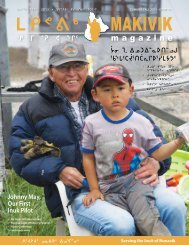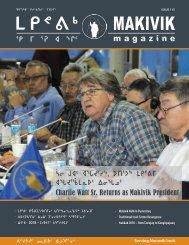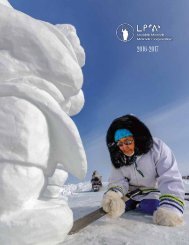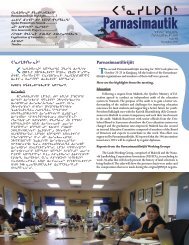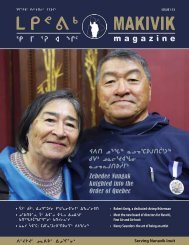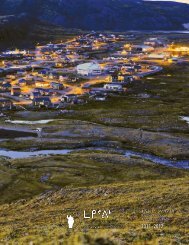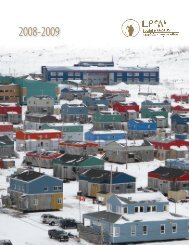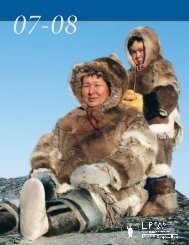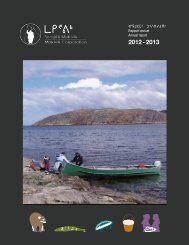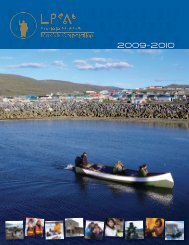Makivik Magazine Issue 102
You also want an ePaper? Increase the reach of your titles
YUMPU automatically turns print PDFs into web optimized ePapers that Google loves.
is SC8hQ4 wo8ix[3Jxu woymJ7mEsNh8iu4 wo8ixg6<br />
uxE ÏDä8 Îx8, gryN3tyAtc3S6 x5pQX§Atq8i4<br />
wkgw8â5 xcsyqbl ñusiC3gl JÉ4aiCbqb,<br />
wªctŒ5nè5 wl3dyE5hQ5 Wy3§tq5.<br />
University of New Brunswick PhD student, Mary Caroline Rowan,<br />
describes similarities between the Inuit Aqausiq and Sámi Yoik,<br />
techniques of cultural singing.<br />
si4v stAm?Q5 wk5J xj5 w8i xiEM sJ/Ci x3Çi sr saM sJJu<br />
WNhctZi4 k xAwu5 É2 Xc3hz. äM xo5ñ8gn8 kt wo8i x[3J xu<br />
wo8i xt5ypj5 wvJ3tQ/ sJ6 ñu x˜+f{Mu f s{Ì0pÉ5ª, k xAwu. x3Çi<br />
®N s/3Ìt sM sJJ6 ‘b3Cu5 b3Cj5’ w8i xDti3u4. Ì4f x x s9MDt5n sht4<br />
®Ns/c3tyAtsJ5 W/sA8NtbsJ5 x3dtQ5hQ5 srs3bgu wo8ix[3Jxf5,<br />
wozJ5 wo8i xtk5 Wg5ymic3gk5 s3gi3nQ x9Mu4 wo8i xi3u4<br />
sr s3bgu s5 kNq8ªozJi4.<br />
c spm9l xq7mEM sJJA4 hNi4 wloc5y xi xCl x3m¯b Ì4f x ‘b3Cu5<br />
b3Cj5’ w8i xDti3ªozJ5 ck3l grc9lgCl x3m¯b grym5y xNQ5 —<br />
ry xi xfi s1qg xW5 bfc5b?9o xyMsJKA4<br />
vmN3gi4 Wg5ym stAtŒ5gi4 wkw5<br />
ckw¬Dyq8ªoz5ht4 wkw5 kNz8il<br />
n2uul. n2u siC3b sJ6 kN xuhwi<br />
kNo3Mdb sJi x?lc3m5, wM st9lQ5<br />
kNdtq5: Îyxus5, [8M8us5, hAwb8us5<br />
k xAwu s9l.<br />
[K xE @)!#-u äM kN[o xM sJJ6<br />
S˜E x3hi by s3[4 v4v˜5 W5J/ s[-<br />
x8k5, vtyQ x3ghi wkgc3i4. woãpi4<br />
xyq8il kN3cb s5ht4 sN7uQ/c3gi4<br />
wo5yQx4viDmi3u4 wkgw8â5 eg3zuk5<br />
w1qDyq8i4. gryAmlx1axhi xcsy3i4,<br />
Wy xW8i4 wkgw8â5 eg3zui4 i5/l5bsyos3ymAtu8i4<br />
i5/l5Ì[cDtQ§q8i4.<br />
äM wo8i x[3J xu wo8i xbui4<br />
WZhAtc3ymJ6 ñü5 JÉ4Dyzi4 gryix7Me5hi,<br />
W sygc3uA nü5 i5/l5ÌDyx8i4<br />
Wy3hDy x8i4. JÉ4 wMq5 mo stJi4<br />
sc syc§5 wMc3ht4 i5/l5b sy3i4<br />
gn3ioEAti4. JÉ4u4 Wi x3ico3©2 grc3tNh5Ì wª2 wªyzªozJi4<br />
s{?l8î5 kN s2 ckw8izi4 i5/l5ÌDy3u gn3n stbsJ6, Wy3hDtsc5bymJ6<br />
W sygc4f5 Wy3hDb s?M s3 S6 Wy3hg6 hNu9lî5 gn3ˆDtQx9Mu4<br />
xg3tNA. Wyo s3g6 wk7j5 xb sy3j5 wozJi4 bµ5 JÉ4o s3-<br />
Xt9lA. Wy3Ìb sJ6 wªA8Ng6 s{?l8î5 kN sli, i3Jt slil8î5,<br />
s{?l8î5 xkE sli. Ì8N JÉ4ÌEAb sJ6 WNh xD8N[c3tlA §3l wo8ixt5ypg5,<br />
sçpg5, X{[ñEpg5, xg3b sA8Nic3uhil wª2 w2Wi xDyq8i4<br />
sçAtc3iu4.<br />
Ö4fNi s9¬M s3ymJ[i3i s2Wi3ul k xAwai3ul d{?tEic7mE5tlQ5<br />
G x3ÇA5 !^))-ü5gi5 WQ x3[Q5hQ5 tr5hA x3ÇA6<br />
!(&)H, ñu5 Wy3§tgc5n/ JÉ4aiC3bz g5y x[8k5 Nlâ3b sicMs3id6<br />
§3l xJ3goi st9lA Ö5hmi g5y xtk5 xJ3i siC3b symJ6<br />
I would like to tell you about a visit I made to Inukjuak last<br />
winter with my colleague from Norway. Laila Aleksandersen<br />
Nutti is an assistant professor at the Sámi Allaskuvla in<br />
Guovdageaidnu, Norway. Last year she received money for a<br />
“North-to-North” exchange. This is a travel grant that is made<br />
available, through the University of the Arctic, for people connected<br />
with post-secondary education in circumpolar places.<br />
We were not exactly sure what being involved in a “Northto-North”<br />
exchange would mean — but it didn’t take long<br />
before we started to notice<br />
interesting connections<br />
between things people<br />
do in Inuit Nunangat and<br />
Sapmi. Sapmi includes the<br />
land originally inhabited<br />
by Sámi which are currently<br />
divided into four<br />
geopolitically separate<br />
nation-states, including:<br />
Russia, Finland, Sweden<br />
and Norway.<br />
In February 2013 Laila<br />
travelled to Nunavik to<br />
visit the Tasiurvik Childcare<br />
Centre and to meet with<br />
elders, educators and<br />
other interested community<br />
members to learn<br />
more about Inuit songs for<br />
children. She was especially curious about aqausiq, which is<br />
a little song made of rhymes and sounds that Inuit sing and<br />
share with babies and young children.<br />
Laila did her master’s degree on the Sámi yoik, a traditional<br />
Sámi song. Some yoiks include rhythmic verses with words<br />
combined with percussive sounds. A yoik performed to takeon<br />
the character of the person or place featured in the music,<br />
and was traditionally sung unaccompanied by instruments.<br />
The composer gifts each yoik to a particular recipient. This<br />
could be a person, a place, an animal, or perhaps the wind.<br />
The yoik can act as a teacher, commenter, teaser, and be used<br />
to express feelings.<br />
CANDACE IKEY<br />
MAKIVIK mag a zine<br />
45






